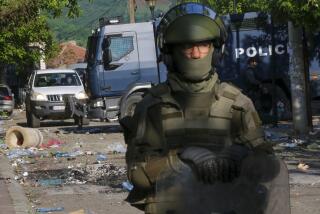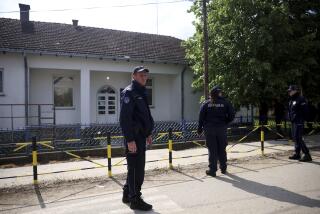Rebels Reportedly Battle Troops in Heart of Province
- Share via
PRISTINA, Yugoslavia — Explosions and bursts of machine-gun fire echoed across Kosovo’s capital Tuesday in what appeared to be a pitched battle between ethnic Albanian guerrillas and Serbian security forces--the first time Pristina has been hit by such combat.
The heavy fighting began about 9:30 a.m., and the sound was loud enough in the center of the city that at first it appeared NATO was delivering on its promise to start bombing Kosovo during the day.
But no air-raid sirens wailed, and NATO did not announce any daylight airstrikes on Pristina at its daily briefing in Brussels, where the alliance said it was set to move to a 24-hour bombardment as cloud cover lifted over the Serbian province.
Pristina’s semiofficial media center, which is run by a Serbian journalist, confirmed that Kosovo Liberation Army guerrillas were battling security forces in the capital’s Sunny Hill district and said Serbian civilians had joined in to repel the KLA attack.
If the report of Tuesday’s battle is true, the operation would be the KLA’s boldest in Pristina since Kosovo’s war began 13 months ago--hardly something that Serbs would want to trumpet in the middle of a war with the North Atlantic Treaty Organization.
Until now, Kosovo’s war has been fought in the countryside, and the closest it has come to Pristina were a few terrorist bombings. It isn’t clear whether those bombings were the work of Serbs or ethnic Albanians.
As night fell Tuesday, and the city’s electricity was turned off while security force units dispersed to avoid NATO bombs, machine-gunners exchanged fire again on the edge of Pristina.
The capital is bracing for more heavy NATO airstrikes after bombers destroyed the Interior Ministry police headquarters in the middle of the city early Monday but left the Yugoslav army’s low-rise headquarters untouched.
The Exodus From Pristina Begins
In the first signs of an impending exodus from the city, a long column of cars carrying ethnic Albanians, ethnic Turks and Serbs fled the city Tuesday morning.
NATO took advantage of a clearing, moonlit sky early Wednesday to pound targets near Pristina again. One attack set off a long series of explosions in rapid succession, indicating a bomber with a large payload had unloaded, lighting up the horizon with a bright white flash that pulsed for several seconds.
KLA guerrillas, whose fight for an independent Kosovo erupted into full-scale war in late February 1998, launched Tuesday’s assault from the nearby village of Maticane, said Radovan Urosevic, the media center director.
Urosevic lives in the Sunny Hill district and said his information came from neighbors whom he contacted by phone.
With a Serbian offensive underway throughout much of Kosovo, it was impossible to confirm Tuesday’s reported battle with KLA sources. But mounting sniper attacks on Pristina in recent days also have suggested that at least a small force of guerrillas is on the capital’s outskirts.
On Monday, police standing near an armored vehicle near Pristina’s stadium came under sniper fire, and a Serbian man with two children said a sniper shot at them in central Pristina.
The city is relatively small and fringed by wooded hills that offer ideal cover for guerrillas, especially now that NATO warplanes are striking Serbian special police and Yugoslav army units in the area almost daily.
Police also reported that “large groups of terrorists,” the Serbs’ official description of the KLA, attacked Yugoslav army and special police units Monday night from Kosovo’s central Drenica region, the guerrillas’ main stronghold.
The area is also one of those where NATO says Yugoslav President Slobodan Milosevic has ordered his security forces to carry out a “final solution” to the Kosovo problem by expelling ethnic Albanians.
If hundreds of thousands of Kosovo Albanians displaced from their homes over the past year are allowed to return someday, even relatively moderate Serbs can’t imagine the two ethnic groups living together.
“With these bombings, the American administration has created huge antagonism between Serbs and Albanians in Kosovo,” said Dusan Ristic, a leader of the Serbian Resistance Movement, a local party opposed to Milosevic.
“It is very hard to see coexistence from now on because of that,” Ristic said. “This wrong policy, under the slogan ‘keeping down tension,’ has in fact led to even greater conflict and instability in Kosovo.”
Ristic’s party joined clerics from the Serbian Orthodox Church to press for a Swiss-style solution in Kosovo at recent peace talks in France.
Under their proposal, Kosovo would be divided into areas similar to Swiss cantons, and the few areas with a Serbian majority would be allowed to have their own police, schools, courts and other security and cultural guarantees.
By contrast, after months of tortuous negotiations before the talks in France, the six Western nations mediating the Balkan crisis--known as the Contact Group--presented a plan for a united Kosovo.
That plan, which enshrined the basic rights of ethnic minorities such as Serbs, was the best compromise for both ethnic Albanians and Serbs in part because it would keep Kosovo part of Serbia, the Contact Group argued.
Milosevic’s negotiators said they were prepared to accept the basic political deal but not 28,000 NATO troops to police the agreement. And as foreign pressure mounted, Milosevic demanded changes in the political text too.
Milosevic Exploits Kosovo Bomb Damage
One of the reasons Serbs are so determined to hold on to Kosovo is that several important medieval churches and monasteries are located here. Milosevic has scored propaganda points from a NATO near-hit that damaged one of the most cherished sites.
On the second night of airstrikes, the Western alliance’s targets included an ammunition dump near the Gracanica monastery, a 679-year-old site that Serbs revere whether they are especially religious or not.
The building, about four miles southeast of Pristina, didn’t suffer a direct hit. But the force of the blasts and secondary explosions cracked its facade, and state television broadcast video of the damage.
The report also described how the monastery had survived a Turkish invasion and two world wars, only to be scarred now by NATO’s attack.
More to Read
Sign up for Essential California
The most important California stories and recommendations in your inbox every morning.
You may occasionally receive promotional content from the Los Angeles Times.










